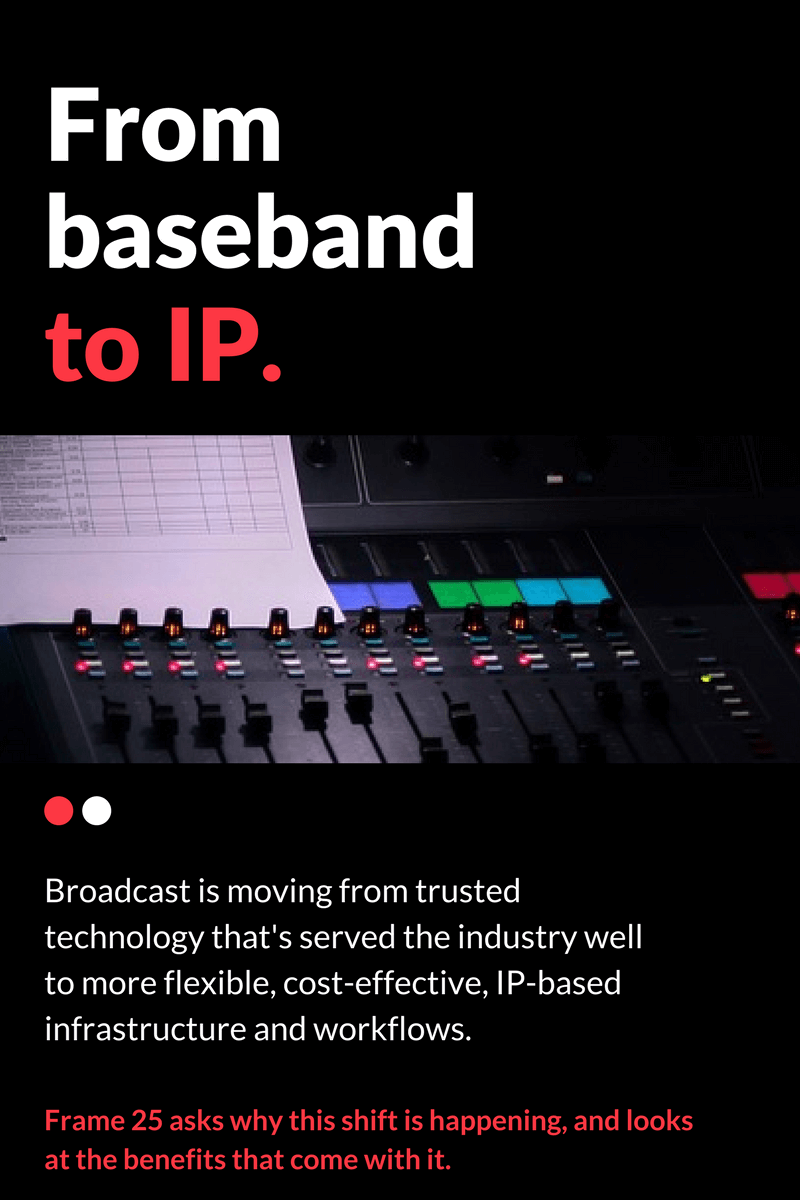
From baseband to IP: the move of broadcast content workflows
IP solutions are popping up all the time now in playout, MCR, studio and live production environments – areas that have traditionally been the realm of SDI baseband.

The shift to IP
Imagine Communications, who provide a range of products and services to an international broadcast-industry client base, wrote in March 2015 that “baseband-only operations are running out of steam”.
Strengthening the relationship between traditional broadcast technology and IT, IP-based infrastructure is presenting a shift in workflows that’s similar and almost as dramatic as the transformation from analogue television to digital.
Some large and influential television facilities are now using IP network architecture, such as the BBC and Timeline TV, consigning traditional mainstays of broadcast technology including routers, coaxial cable and BNC connectors to history.
Timeline are working closely with SAM (also known as Snell Advanced Media) to launch a brand-new outside broadcast truck providing fully uncompressed 4K and high dynamic range (HDR) content over IP.
Newbury-based SAM have been busy installing technology into studio and sports facilities that they believe is going to replace EVS in the coming years.
The company’s LiveTouch system is competing head-to-head with IP4Live, a similar product from EVS – for so long the mainstay of instant replays and slow-mo action in live sports broadcasting.
SAM’s Head of Product Marketing, Tim Felstead, said: “We are offering something better, smaller, faster, and cheaper,” as his company launched the product at IBC 2016.
Why the shift to IP?
The scale and flexibility trumpeted by SAM and others are among the major benefits of IP, particularly since the technology has become common place for transporting all kinds of data as files and, more recently, real-time streaming of video and audio.
With IP enabling broadcasters and facilities to “do more with less”, the value is in the network.
The greater the demand for content, the more urgent and important the need for networks to support it.
From SDI Baseband to IP Routing: An Essential & Timely Migration, a whitepaper published in 2015, stated:
The professional television industry has embraced IP technology in many areas including video point-to-point transport and wireless HD-ENG backhaul.
But, because the TV-specific professional “coaxial-based” streaming formats (SDI, HD-SDI, 3G-SDI) require TV-specific digital routing systems, commercial IP-based data centre networks were not implemented in the broadcast plant.
Until now. The television industry is currently facing the need for tremendous amounts of content distribution as well as supporting new 4K-UHD formats that require switching of uncompressed video at bitrates of 12Gbps and above. It is simply impractical, or even impossible, to accomplish this with traditional broadcast SDI router design…
Benefits of moving to an IP-based workflow
Jamie Shepperd, Group Marketing Manager at Adder Technology, makers of keyboard, video and mouse (KVM) switches, matrices and other products, wrote:
The main attraction of using IP is that it is ubiquitous, cost-effective and is based on common standards. It is also a mature technology, used by other industries who have already overcome adoption challenges and other issues, which means the broadcast industry can benefit from this experience when it comes to their own adoption.
But the area where it has really proved itself is in switching and extension – via KVM technology. IP-based high performance KVM removes the limitations of traditional AV equipment and brings real-time, accurate video operation to users. The technology allows operators to switch between machines that are sometimes located a great distance away, from a single workstation using just one keyboard and mouse.
Finally, within the past month, the Digital Production Partnership (DPP) has released Business Benefits of IP, “the first-ever assessment of where broadcasters, producers and suppliers can expect to see the greatest return on investment from committing to IP-based production”.
Among other things, it found that “the greatest disruption sits in the cloud”:
If looking to gain early-mover advantage, investors should pay attention to IP-based media management, cloud playout and post production. This is where technology change could facilitate major disruption in operating models – and give meaning and purpose to other major innovations, such as machine learning, analytics and AI.
The research creates a picture of IP impacting every aspect of media production. It becomes clear that the industry is nearing a tipping point.

In The Frame - April '23

In The Frame - March '23
